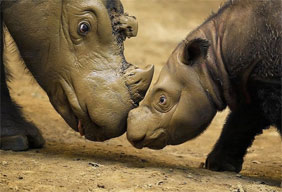Session 4/15
Page 2/5: Topic A: Basic Attachment Theory and the Attachment SystemTopic introduction A: Basic Attachment Theory and the Attachment System
JOHN BOWLBY
John Bowlby was an English child psychiatrist who studied grief reactions in children and babies who had been abandoned by their parents in World War 2. From these experiences, he formed the Attachment Theory of human child development.
His first question was: “Why are children attached to their parents for so long after birth and while growing up?”

WHY DO ALL MAMMALS PRACTICE ATTACHMENT BEHAVIOUR?


- In the primitive forms of life (reptiles, fish, insects) the “mother” has a lot of offspring at the same time. One gold fish may lay thousands of eggs in one hour. But the “mother” does not care a lot for her offspring once they are out of the egg. This is because the brain development is finished while the foetus is still inside the egg. So when the “baby” comes out of the egg, it is ready to function – it can crawl or swim or hunt or eat immediately. It does not need “maternal caregiving” – the brain development is already completed before hatching happens.
- Mammals (animals who breastfeed their offspring, such as cats, dogs, whales, gorillas and humans) have a very different strategy and a much more complex brain. They have much fewer babies at a time, and they care for each baby. Human babies are born with very immature brains, and the parents can form and program the brain because it is immature for many years. Children can learn from adults to read, to think, to be social, to solve problems, etc. You “build your brain” through upbringing and care from caregivers.
- It takes 16-20 years before the human brain is fully developed, and in all those years you need care and support from caregivers.
QUESTIONS
- Do you have domestic animals or know anyone with domestic animals? How do the parents care for their offspring after birth?
- What do they do when caring for their offspring? How long do they keep them before they can take care of themselves?
WHAT IS ATTACHMENT BEHAVIOUR?



- There is one big problem with this survival strategy in mammals: the brain of the new-born is not able to function very well, so the baby is helpless. It’s life depends completely on adult caregivers, especially for the first years of life.
- This is why humans have an attachment system: feeling attached gives the baby security, protection and care. So attachment behaviour is:
- The baby’s tendency to seek protection, care and nursing from adult caregivers.
- If a baby is left completely alone for a long time, it will die. Therefore babies tend to avoid physical separation and respond with attachment behaviour. The attachment system is an alarm system to prevent separation:
- The attachment system is activated by separation and or fear of separation.
- Avoiding physical separation is the baby’s only chance for survival.
- The baby avoids separation by clinging, and crying, and protesting when the caregiver tries to leave.
- This is normal and healthy attachment behaviour. Babies who do not respond when the caregiver leaves may have given up looking for care (resignation). They may be described as “very calm”, but this behaviour is not normal. Babies who panic when caregivers leave may have experienced very difficult and anxious separations. These are not healthy reactions, and you often see them in children whose biological parents were not able to care for them.
- To provide secure attachment is most important in the early years of life, while the basic trust and attachment system is formed. Shifts in caregivers and dysfunctional care can disturb healthy attachment and the ability to love and socialize. For this reason, in many countries the law no longer allows children younger than three years to enter institutions, but demands that they are placed in a foster family.
QUESTIONS
- Can you remember seeing your own children show healthy attachment behaviour (that is crying and protesting when separated from you but easy to calm down when you return)
- When do you see this behaviour in the children you work with? Are there any children who don’t react at all when caregivers leave? Are there children who go into long time panic or feel rejected and betrayed when the caregiver leaves? How easy is it to calm these children down when reunited?
- What are our practices when children show normal attachment behaviour?
- How do we respond (sooth them, scold them, think of them as “disturbing”, do we get stressed when they cry? Or…?).
- What will parents do in our local culture when children show attachment behaviour and seek protection?
- What did your mother and/or father say about how to handle clinging babies?

CHECKLIST FOR UNDERSTANDING
- Who developed the Attachment Theory?
- Why do only mammals (especially humans) have the attachment system?
- Describe normal attachment behaviour with an everyday example from your work.
- Describe children with insecure attachment behaviour from your work.
